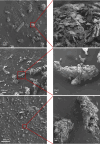The Invisible Footprint of Climbing Shoes: High Exposure to Rubber Additives in Indoor Facilities
- PMID: 40370931
- PMCID: PMC12070412
- DOI: 10.1021/acsestair.5c00017
The Invisible Footprint of Climbing Shoes: High Exposure to Rubber Additives in Indoor Facilities
Abstract
There is growing concern about rubber-derived compounds (RDCs), predominantly originating from tire and road wear particles. Other consumer products, including sports equipment, also contain RDCs, and human exposure to these compounds is of particular interest due to demonstrated toxicity to animal species. In this study, we investigated RDCs intentionally incorporated into climbing shoes for enhanced performance. We found high concentrations of 15 RDCs in shoe sole samples (Σ15 RDCs: 25-3405 μg/g), aerosol particulate matter (Σ15 RDCs: 2.6-37 μg/g), and settled dust (Σ15 RDCs: 1.5-55 μg/g) in indoor climbing halls. The estimated daily intake via inhalation/ingestion of Σ15 RDCs for climbers and employees in some of these facilities ranged from 1.7 to 48 ng/kg/day, exceeding known intake levels of RDCs from other sources. Abrasion powder resulting from friction between climbing shoes and footholds is the likeliest source of high concentrations of RDCs observed in aerosol particulate matter and settled dust. These findings reveal a previously unknown human exposure route of RDCs.
© 2025 The Authors. Published by American Chemical Society.
Conflict of interest statement
The authors declare no competing financial interest.
Figures





Similar articles
-
Dust exposure in indoor climbing halls.J Environ Monit. 2008 May;10(5):648-54. doi: 10.1039/b719344k. Epub 2008 Mar 26. J Environ Monit. 2008. PMID: 18449402
-
Occurrence, sources, and human exposure assessment of amine-based rubber additives in dust from various micro-environments in South China.Sci Total Environ. 2024 Dec 10;955:177023. doi: 10.1016/j.scitotenv.2024.177023. Epub 2024 Oct 17. Sci Total Environ. 2024. PMID: 39423893
-
Small-Intensity Rainfall Triggers Greater Contamination of Rubber-Derived Chemicals in Road Stormwater Runoff from Various Functional Areas in Megalopolis Cities.Environ Sci Technol. 2024 Jul 23;58(29):13056-13064. doi: 10.1021/acs.est.3c10737. Epub 2024 Jun 20. Environ Sci Technol. 2024. PMID: 38900493
-
Pollutants in house dust as indicators of indoor contamination.Rev Environ Contam Toxicol. 2002;175:1-46. Rev Environ Contam Toxicol. 2002. PMID: 12206053 Review.
-
Spatiotemporal analysis and human exposure assessment on polycyclic aromatic hydrocarbons in indoor air, settled house dust, and diet: A review.Environ Int. 2015 Nov;84:7-16. doi: 10.1016/j.envint.2015.07.006. Epub 2015 Jul 18. Environ Int. 2015. PMID: 26197059 Review.
References
-
- Berry N.Social Climbers - The Evolving Indoor Climbing Industry. UKC, 2018. https://www.ukclimbing.com/articles/features/social_climbers_-_the_evolv... (accessed 2023-08-07).
-
- Market of Climbing Gyms Germany. Buisnesscoot: Paris, 2023. https://www.businesscoot.com/en/study/the-market-of-climbing-gyms-germany.
LinkOut - more resources
Full Text Sources
